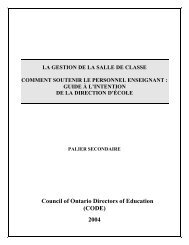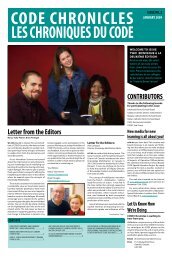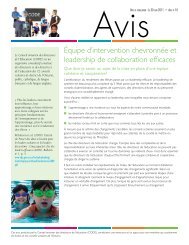Boston College Leading for All: A research report of the ... - CODE
Boston College Leading for All: A research report of the ... - CODE
Boston College Leading for All: A research report of the ... - CODE
You also want an ePaper? Increase the reach of your titles
YUMPU automatically turns print PDFs into web optimized ePapers that Google loves.
Ontario’s exemplary per<strong>for</strong>mance mainly in terms <strong>of</strong> are<strong>for</strong>m strategy comprising a set <strong>of</strong> policies that have placed a focus on literacy and numeracy, aswell as high school completion; clearly defined and persistently pursuedmeasurable targets in student achievement; involved major stakeholders in <strong>the</strong>development and delivery <strong>of</strong> <strong>the</strong> strategy -including <strong>the</strong> teacher federations with whom<strong>the</strong> provincial government establishedconditions <strong>of</strong> peace and stability; avoided punitive interventions where schoolsshowed evidence <strong>of</strong> struggling and insteadprovided extensive support systems <strong>of</strong>training, coaching and networking to helpteachers and schools improve achievement;and created data systems to track progress andintervene in real time whenever students orschools appeared to be falling behind.This strategy has been <strong>the</strong> planned, stated, receivedand recommended (OECD, 2010, 2011; McKinsey &Company, 2010; National Center <strong>for</strong> Education and <strong>the</strong>Economy, 2011; Barber, 2007; Fullan, 2003, 2006,2009; Levin, 2009) <strong>the</strong>ory <strong>of</strong> change in <strong>the</strong> province.As OECD (2011) itself acknowledges, in ascomplex a setting as provincial, state or nationaleducation policy, it is difficult – if not impossible – toattribute achievement gains to one particular policy orano<strong>the</strong>r (see also Loveless, 2012). Accordingly, weneed to consider how a wide range <strong>of</strong> policy strategiesand <strong>the</strong>ir interactions may affect student achievementin high per<strong>for</strong>ming and rapidly improving countries.This review and <strong>report</strong> addresses one such aspect <strong>of</strong>Ontario educational policy.Given Ontario’s per<strong>for</strong>mance record and globalpr<strong>of</strong>ile, undertaking an independent investigation <strong>of</strong>any aspect <strong>of</strong> educational re<strong>for</strong>m in <strong>the</strong> province is amatter <strong>of</strong> importance <strong>for</strong> <strong>the</strong> province itself, and also<strong>for</strong> those who are launching or assessing educationalre<strong>for</strong>m ef<strong>for</strong>ts across <strong>the</strong> world. This <strong>report</strong> is based onan investigation and review <strong>of</strong> one significantcomponent <strong>of</strong> Ontario’s overall re<strong>for</strong>m strategy: <strong>the</strong>implementation <strong>of</strong> a major <strong>report</strong> on special educationthat addressed how to provide better services andsupport <strong>for</strong> <strong>the</strong> province’s highly diverse studentpopulation, including but not restricted to those with<strong>for</strong>mally identified needs.Special education policy historyOver <strong>the</strong> past half-decade, provincial policiesgoverning special educational needs have moved froman era <strong>of</strong> external en<strong>for</strong>cement <strong>of</strong> placements to morelocalized and pr<strong>of</strong>essional discretion concerning ways tocreate more inclusive environments <strong>for</strong> all students. Themovement towards greater educational inclusion <strong>for</strong>students with special educational needs began in <strong>the</strong>1960s with dissatisfaction about re<strong>for</strong>ms in <strong>the</strong> generaleducation curriculum. Some special educators began toargue “that most children with exceptionalities werebetter served when <strong>the</strong>y stayed with <strong>the</strong>ir peers in aregular classroom” (Gidney, 1999, p. 153). Although<strong>the</strong>re were many advocates <strong>for</strong> mainstreaming,legislation that called <strong>for</strong> additional services <strong>for</strong>students with special educational needs, particularly‘Bill 82’, was not established until <strong>the</strong> late 1970s andearly 1980s. At this time, “inclusion was defined as aplacement, not as <strong>the</strong> provision <strong>of</strong> programmes andservices within <strong>the</strong> placement” (Jordan, 2001, p. 353).In <strong>the</strong> 1990s, <strong>the</strong> emphasis <strong>of</strong> educationalre<strong>for</strong>m was redirected from resource inputs tomeasurable outputs in <strong>the</strong> <strong>for</strong>m <strong>of</strong> benchmarks andoutcomes in <strong>the</strong> case <strong>of</strong> <strong>the</strong> New Democratic Partygovernment, and standards and high-stakesexaminations in <strong>the</strong> case <strong>of</strong> its Progressive Conservativesuccessor. The latter’s policies in particular mandateduniversal achievement, but by standardizing many o<strong>the</strong>raspects <strong>of</strong> <strong>the</strong> curriculum and reducing resourcesavailable to public schools boards, <strong>the</strong>y left teacherswithout <strong>the</strong> tools to implement <strong>the</strong>se ideas.Education <strong>for</strong> <strong>All</strong>In 2005, <strong>the</strong> Ontario Ministry <strong>of</strong> Educationpublished a <strong>report</strong> based on <strong>the</strong> findings andrecommendations <strong>of</strong> an expert panel that <strong>for</strong>mulatedguiding principles <strong>for</strong> more fully educating studentswith identified special needs. The visionary newprovincial policy document, Education <strong>for</strong> <strong>All</strong> (EfA),sought to “assist teachers in helping all <strong>of</strong> Ontario’sstudents learn, including those students whose abilitiesmake it difficult <strong>for</strong> <strong>the</strong>m to achieve <strong>the</strong>ir grade levelexpectations” (pp. 4-5). The document set out sevenPage4 | <strong>Leading</strong> <strong>for</strong> <strong>All</strong>











